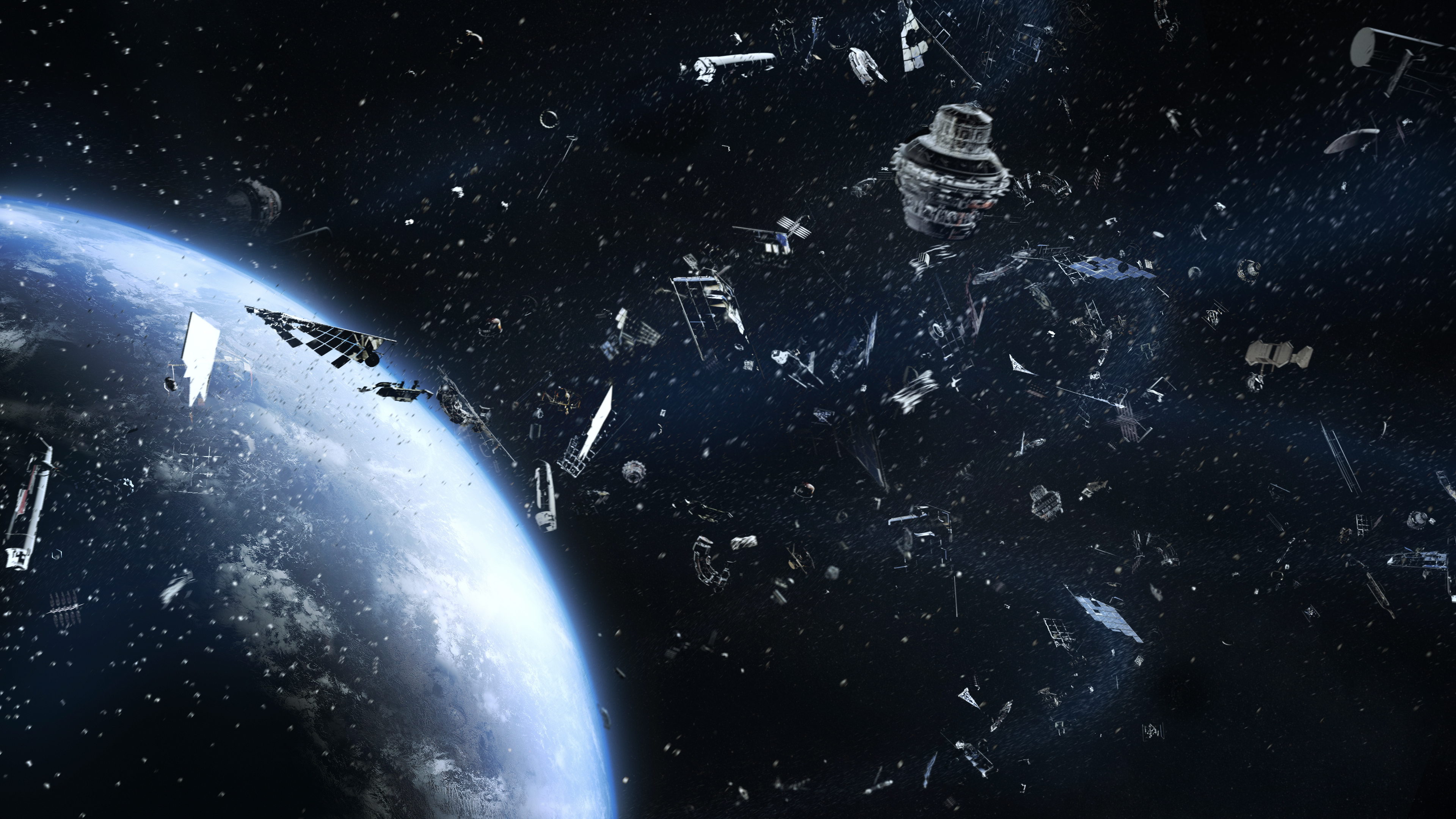Space junk: How broken satellites are creating a garbage crisis in the sky
Thousands of pieces of space debris, also known as space junk, are orbiting Earth, with tons more added each year. This orbital debris poses a significant threat to satellites, spacecraft, astronauts — and increasingly humans on Earth.

On June 27, 2024, nine astronauts aboard the International Space Station (ISS) were forced to take shelter in a docked crew capsule after a nearby Russian satellite shattered into more than 100 pieces, showering the sky with potentially hazardous debris.
Though the astronauts returned to the ISS roughly an hour later and resumed operations as normal, the scare brought into sharp focus the growing crisis of space junk in Earth's crowded atmosphere.
Space debris — known colloquially as space junk — is the name that scientists give to the tens of thousands of pieces of broken satellites and spacecraft that clog Earth's orbit. Space junk can be as small as a paint fleck or as large as an abandoned rocket launch vehicle; no matter the size, orbital debris poses a significant threat to the astronauts and spacecraft that work in Earth's orbit, according to NASA.
The amount of space junk in orbit increases hand-in-hand with the growth of the space industry on Earth. On March 10, a group of international researchers writing in the journal Science raised the alarm on the growing problem of space junk, calling for a legally-binding treaty to "help protect Earth's orbit" before it becomes irreparably polluted with debris. Despite this, private companies continue to pump a record number of new satellites into orbit each year — and Earth is starting to see the consequences in ways that are impossible to ignore.
Here's everything you need to know about space junk, and why scientists are concerned.
What is space junk?
Space junk refers to any human-made debris left in orbit around Earth.
This includes fully intact satellites that have run out of power and been left in orbit after the end of their missions, as well as broken chunks of machinery created when larger objects collide. Even tiny chips of paint that have been ripped off of rockets count as space junk.
How much space junk is there right now?
Scientists currently track more than 29,000 pieces of space junk that are larger than a softball, according to the European Space Agency (ESA). This includes about 3,000 defunct satellites that have been left to decay in orbit, according to the Natural History Museum of London.
Get the world’s most fascinating discoveries delivered straight to your inbox.
However, most pieces of orbital debris are far too small to be tracked. Researchers estimate that there are more than 100 trillion untracked pieces of space junk in Earth orbit, according to the Science study. The vast majority of this untracked debris is likely less than 0.4 inches (1 centimeter) wide.
However, even tiny pieces of space junk can pose big problems for functional spacecraft.
Why is space junk a problem?
Even tiny pieces of space junk can cause incredible damage. That's because objects in orbit move incredibly quickly, typically reaching speeds of greater than 15,600 mph (25,200 km/h), or 10 times the speed of an average bullet shot on Earth. If two objects moving in opposite directions collide with one another in space, then the impact becomes even greater.
This means that even pea-size objects can become dangerous missiles in orbit. This was illustrated in 2016, when a small paint fleck collided with a window on the ISS, gouging a quarter-inch dent into the glass. (Fortunately, the window held).
Can space junk fall to Earth?
Yes, space junk frequently falls to Earth. On average, anywhere from 200 to 400 pieces of tracked space debris plummet through Earth's atmosphere every year, according to the National Oceanic and Atmospheric Administration.
Most of this free-falling junk is small enough that it burns up entirely in the atmosphere, never reaching the ground. Larger objects that can survive the fall (like satellites) typically splash down into the ocean, but not always.
In August 2022, a charred, spike-like chunk of a SpaceX Crew Dragon spacecraft fell through the atmosphere and landed on a sheep farm in Australia.
On March 8, 2024, a mysterious object crashed through two floors of a Florida family's home. NASA later confirmed that the object was part of a cargo pallet containing 5,800 pounds (2,630 kilograms) of used batteries that were jettisoned from the ISS in March 2021. Nobody was injured, but the alarmed family filed a claim with NASA seeking payment for the damages.
Near-miss incidents like these are becoming increasingly common. In May 2024, a large chunk of a SpaceX Dragon capsule crashed onto a luxury campground in the mountains of North Carolina. That same month, another large piece of a SpaceX Dragon capsule crash-landed on a Canadian farmer's property in Saskatchewan.
Beyond the clear physical risks of falling space junk, recent studies have found that deorbiting spacecraft may also be polluting the atmosphere with metal contaminants, and possibly depleting the ozone layer. Further study is needed to fully understand the unseen effects of orbital debris burning up in our planet's atmosphere.
Space junk incidents in orbit
On Feb. 10, 2009, a defunct Russian spacecraft crashed into a functioning U.S. Iridium commercial spacecraft, destroying both and adding more than 2,300 pieces of trackable space junk to orbit, according to NASA.
In March 2021, a piece of a Russian rocket collided with and destroyed a functioning Chinese military satellite.
In June 2021, a small piece of unidentified space junk slammed into the International Space Station's robotic arm, damaging but not destroying it.
Incidents are occuring more frequently as more space junk is added to orbit each year.
Editor's note: This article was updated on June 28, 2024, to include new space junk statistics and add recent incidents of space junk falling to Earth.

Brandon is the space / physics editor at Live Science. With more than 20 years of editorial experience, his writing has appeared in The Washington Post, Reader's Digest, CBS.com, the Richard Dawkins Foundation website and other outlets. He holds a bachelor's degree in creative writing from the University of Arizona, with minors in journalism and media arts. His interests include black holes, asteroids and comets, and the search for extraterrestrial life.




